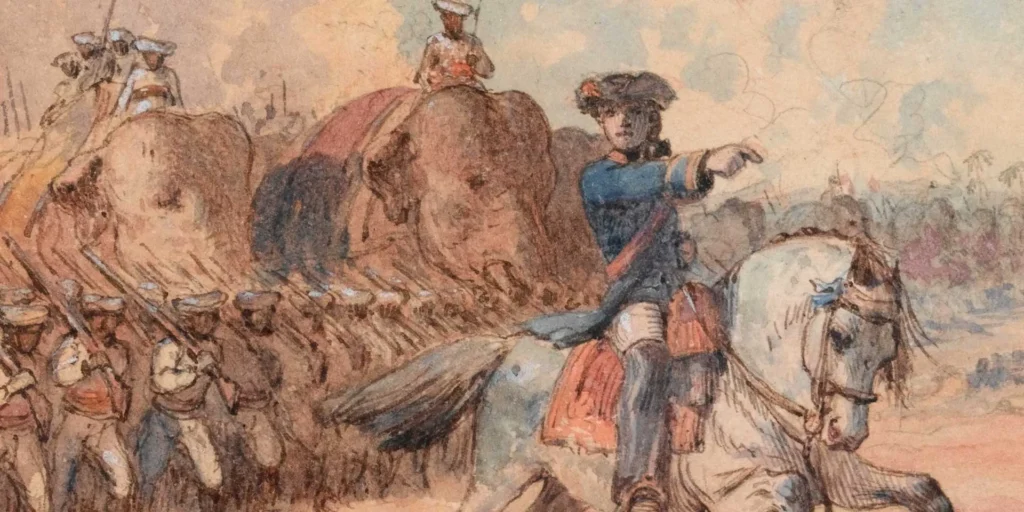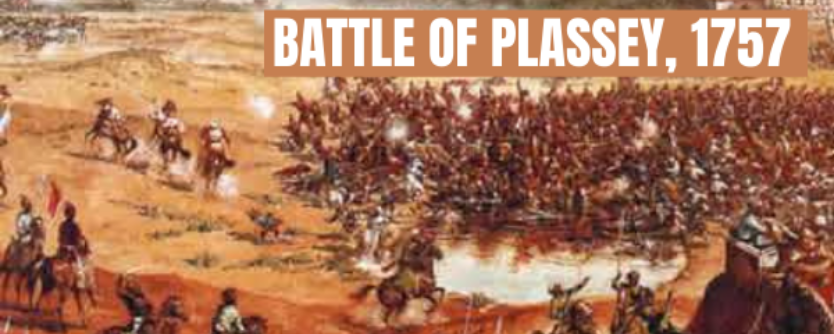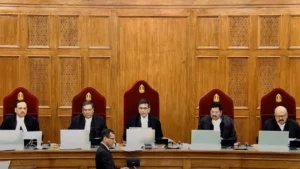The Battle of Plassey is a turning point in Indian History. This epic battle marks the beginning of the establishment of rule of the English East India Company in India. It was through this battle that the EIC got the diwani rights( rights to collect revenues of Bengal , Bihar and Orissa. And subsequently what began was the ‘Drain of Wealth’ from the erstwhile Bengal State that many of the historians have popularly described as Plassey Plunder.
The Causes of Battle of Plassey 1757.
The battle of Plassey 1757 may appear instant or spontaneous, but it was a culmination of several reasons .
- Firstly, the friction between the EIC and Nawab of Bengal was the controversial Farukhshiyar’s Royal Farman of 1717. Major provisions of this Royal Farman granting special trade privileges to EIC were unacceptable to the Nawab of Bengal.
- Secondly, the rampant misuse of dastak ( trade permits for EIC) by EIC officials who at a time made 50 times of their salary due to private trade. Also they were sharing the dastaks to Non-EIC & Indian traders too. This saw a considerable dip in the Nawab’s revenues.
- Thirdly, without the permission of the Nawab, EIC began fortifying their settlement of Fort William which later became Presidency.
- EIC gave asylum to fugitive Krishna Ballabh who ran away with considerable amount of money from the Royal treasury of Bengal.
- Also the personal conduct and character of the Nawab Bengal Siraj ud-daula was under hammer by his subjects and courtiers who found him to be arrogant and misbehaving.
How the Battle unfolded?
Despite repeated warnings by Siraj- ud- Daula against misuse of dastaks, the Nawab took over the EIC factory at Kasimbazar and captured Calcutta. When informed about this happening, Robert Clive – Governor General of Bengal with 3000 thousand soldiers easily defeated the Nawab and signed the Treaty of Alinagar 1756 that restored all the trading privileges of EIC in Bengal.
Having taught the Nawab a good lesson Robert Clive was not interested in killing or dethroning the young Nawab, but when Mir Jaffer ( Commander of the Bengal Army) and Jagat Seth ( Influential banker) tired of Siraj- ud- Daula’s autocratic, arrogant and rude behavior approached Robert Clive with better terms, the 3000 soldiers of Clive supported by Mir Jaffer and Jagat Seth met the 50000 soldiers army of Nawab at Plassey at the bank of the river Bhagirathi.
The Nawab lost in no time and fled the war scene. Later he was caught by Mir Jaffer’s son and killed. This Mir Jaffer became the new Nawab of Bengal.

Consequences of the Battle.
As already mentioned, this war was the beginning of the establishment of British rule in India.
- Mir Jaffer became just a puppet in the hand of EIC.
- Plassey Plunder began where Bengal was literally looted of its treasury.
- The structure of EIC trade changed. Now EIC was not required to pay in gold for trade but it used Indian wealth acquired as capital.
- The rampant misuse of dastaks continued.
Conclusion
Though the Battle of Plassey 1757 did not establish East India Company as the political masters of the country, they definitely emerged as the sole trading masters in the country. Therefore, Battle of Plassey 1757 is a turning point in Indian history that indicated the financial consolidation of British rule in India.












